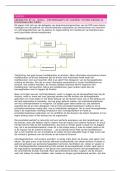Resume
Marketing - IGCSE edexcel business studies summary notes
- Cours
- Établissement
- Book
Estos apuntes/resumen los hice yo mismo mientras cursaba Edexcel IGCSE business en Y9-Y10. Son unos apuntes espectaculares, donde esta todo explicado en detalle. Además de la información del libro, hay bastantes cosas que saque yo personalmente de otras plataformas. Finalmente, usando estos apunt...
[Montrer plus]






